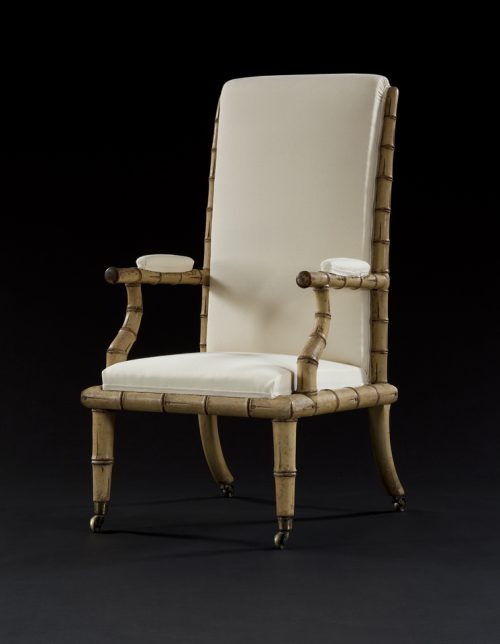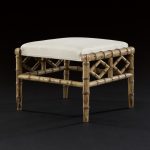9442 A RARE PAIR OF REGENCY FAUX BAMBOO LIBRARY CHAIRS EN SUITE FOOTSTOOL BY MILES AND EDWARDS English. Circa 1825. Measurements: The Chairs: Height: 43 1/4″ (110cm); Width: 21 1/4″ (54cm); Depth: 27 1/2″ (70cm). The Footstool: Height: 15 1/4″ (39cm); Width: 22″ (56cm); Depth: 20″ (51cm).

Research
Of beech, carved and painted to simulate bamboo. The chairs, each with a scrolling upholstered back with faux bamboo uprights the upholstered arms supported by down-swept faux bamboo armrests, the upholstered seat set upon a faux bamboo seat rail, the whole raised on four legs, the pair to the rear of sabre form. The footstool with upholstered seat rail above a pierced lozenge frieze, the whole raised on four faux bamboo legs.
Marks:
One chair bears the stamp:
MILES & EDWARDS 134 OXFORD ST LONDON 8559
Stool bears the stamp:
MILES & EDWARDS 134 OXFORD ST LONDON 8734
The present chairs and stool bear the mark of the cabinet makers Miles and Edwards of 134 Oxford Street, London. Establishing their shop in 1822, Henry Miles and John Edwards became a prestigious firm, handling many important commissions, including work for the British Ambassador in Paris and the Empress of Russia in 1830, together with work at houses such as Hopetoun House, Lothian and Stafford House, London.1
The suite’s simulated bamboo design is reminiscent of the fantastical chinoiserie furniture of one of the Regency’s most remarkable buildings, the Brighton Pavilion. Built by Henry Holland and decorated by many of the leading craftsmen of the day, it was a bold interpretation of the Chinese style which celebrated the fantastical and the illusory. Trompe l’oeil decoration, such as painted views and animals abounded, and the faux bamboo furniture found throughout the residence formed part of this playful scheme.2
Commissioned from the celebrated cabinetmakers Edward, Marsh and Tatham around 1802, these pieces of furniture were ingenious simulations, devised of woods such as beech carefully carved and painted to resemble the more exotic material, bamboo. This same technique, executed to particularly high standard, can seen in the present suite. Moreover, the pierced bamboo frieze of the footstool can be directly compared to the pattern of the faux bamboo fire guard in the King’s Library at Brighton, recorded in a drawing by A.W.N. Pugin in 1823.3
While the bamboo seat furniture at Brighton is all fitted with cane seats and backs, the present chairs were originally upholstered and covered in extremely finely printed silk with delicate chinoiserie decoration, which had survived on the chairs under a later covering. This luxurious upholstery suggests that the present chairs were part of one of Miles and Edwards’ important commissions.
It is interesting to note that one of Miles and Edwards’ most notable commissions was for Burton Constable Hall, the Yorkshire residence of the Clifford-Constable family. Carried out between 1834-35, their work was part of extensive refurbishment of the property which included the construction of a Chinese Room, inspired by visits made to Brighton Pavilion by Marianne, Lady Clifford-Constable and her sister Eliza.4 Clearly the Pavilion’s unprecedented and exuberant realization of a romantic imaginary world had a profound influence on the aristocratic taste of the day and it is as part of such an opulent chinoiserie interior in a grand country residence that the present set of furniture was undoubtedly created.
Footnotes:
1. G. Beard and C. Gilbert, eds., Dictionary of English Furniture Makers, 1660 – 1840, Leeds, W.S. Maney and Son Ltd., 1986, p. 606.
2. J. Dinkel, The Royal Pavilion, Brighton, London, Philip Wilson, 1983, p. 18, 34.
3. J. Morley, The Making of the Royal Pavilion, Brighton, London, Sotheby’s Publications, 1984, p. 224.
4 G. Beard and C. Gilbert, eds., Dictionary of English Furniture Makers, 1660 – 1840, Leeds, W.S. Maney and Son Ltd., 1986, p. 606.


Comments are closed.